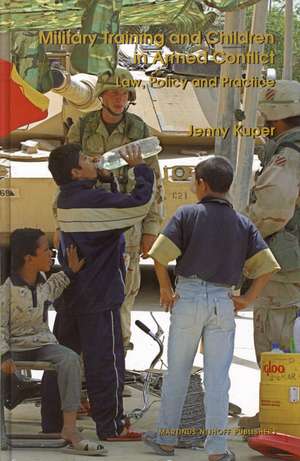Military Training and Children in Armed Conflict: Law, Policy and Practice
Autor Jenny Kuperen Limba Engleză Hardback – 27 feb 2005
This book aims to address three main questions: what are the obligations of officers of national armed forces in relation to children, either civilians or combatants, whom they or those under their command may encounter while participating in situations of armed conflict? How realistic and achievable are these obligations? How can compliance with them be encouraged, monitored, and/or enforced? The book examines these questions in the context of military training. In doing so, it has another inextricably linked aim: to see if there are ways in which the training of officers can improve the protection of children in armed conflict situations, in accordance with international law and policy.
It is intended for use particularly by those involved in training of national armed forces, including officers themselves, and members of governments, non-governmental organisations (NGOs) and inter-governmental organisations. It is hoped that it will also be of interest to lawyers, academics and others concerned with ‘child rights’ and related law and policy.
It contains examples of actual training materials that can be modified for use in different countries and contexts.
Preț: 753.38 lei
Preț vechi: 918.75 lei
-18% Nou
Puncte Express: 1130
Preț estimativ în valută:
144.20€ • 148.60$ • 121.74£
144.20€ • 148.60$ • 121.74£
Carte indisponibilă temporar
Doresc să fiu notificat când acest titlu va fi disponibil:
Se trimite...
Preluare comenzi: 021 569.72.76
Specificații
ISBN-13: 9789004136731
ISBN-10: 9004136738
Pagini: 299
Dimensiuni: 162 x 244 x 25 mm
Greutate: 0.73 kg
Editura: Brill
Colecția Brill | Nijhoff
ISBN-10: 9004136738
Pagini: 299
Dimensiuni: 162 x 244 x 25 mm
Greutate: 0.73 kg
Editura: Brill
Colecția Brill | Nijhoff
Notă biografică
Jenny Kuper is a Research Fellow at the London School of Economics. Her Ph.D. (from King’s College, London) was published by Oxford University Press: International Law Concerning Child Civilians in Armed Conflict (1997). Prior to this, she worked for a number of years as a UK lawyer, particularly with The Children’s Legal Centre, a national child advocacy organisation.
Cuprins
Preface;
Acknowledgements;
Contents;
Abbreviations;
Table of Treaties and Other Selected Legal Instruments;
1. Introduction: Context, Questions and Framework; Part 1 Law and Policy Relevant to the Training of Officers of National Armed Forces as Regards the Treatment of Children at the Outset, During, and Shortly After Situations of Armed Conflict;
2. Part I(A)(1)—Law and Policy: Content of Rules Relevant to Officer Training —Parameters and Basic Principles;
3. Part I(A)(1)—Law and Policy: Content of Rules Relevant to Officer Training Regarding Children—Child Civilians;
4. Part I(A)(1)—Law and Policy: Content of Rules Relevant to Officer Training Regarding Children—Child Soldiers;
5. Part I(A)(1)—Law and Policy: Content of General Rules Relevant to Officer Training Regarding Children—Landmines, Culpability/Command Responsibility, and Selected War Crimes Trials (1998-2001);
6. Part I(A)(2)—Law and Policy: Obligations of Governments—Treaty Law, ‘Soft Law’, and the Committee on the Rights of the Child;
7. Part I(B)—Impact of Law and Policy: Methodology; Part II Practice: Training for Officers of National Armed Forces on the Treatment of Children—Country Studies and the ICRC;
8. Part II—Introduction and Country Studies (Category A);
9. Part II—Country Studies (Category B) and the ICRC;
Part III Summary and Recommendations; 10. Conclusion; Appendices;
1. Captured Child Soldiers in Non-International and in International Armed Conflict;
2. Civil-Military Cooperation: Save the Children, West Africa;
3. Charts: I) Child-Related Training Materials—Eleven Selected Countries, and II) Summary of Comments—San Remo Institute;
4. ‘Background Notes’ to Country Studies—Category (A) and Category (B);
5. Sample Training Materials;
6. Summary: Key Rules Regarding Child Civilians and Child Soldiers;
Bibliography;
Index.
Acknowledgements;
Contents;
Abbreviations;
Table of Treaties and Other Selected Legal Instruments;
1. Introduction: Context, Questions and Framework; Part 1 Law and Policy Relevant to the Training of Officers of National Armed Forces as Regards the Treatment of Children at the Outset, During, and Shortly After Situations of Armed Conflict;
2. Part I(A)(1)—Law and Policy: Content of Rules Relevant to Officer Training —Parameters and Basic Principles;
3. Part I(A)(1)—Law and Policy: Content of Rules Relevant to Officer Training Regarding Children—Child Civilians;
4. Part I(A)(1)—Law and Policy: Content of Rules Relevant to Officer Training Regarding Children—Child Soldiers;
5. Part I(A)(1)—Law and Policy: Content of General Rules Relevant to Officer Training Regarding Children—Landmines, Culpability/Command Responsibility, and Selected War Crimes Trials (1998-2001);
6. Part I(A)(2)—Law and Policy: Obligations of Governments—Treaty Law, ‘Soft Law’, and the Committee on the Rights of the Child;
7. Part I(B)—Impact of Law and Policy: Methodology; Part II Practice: Training for Officers of National Armed Forces on the Treatment of Children—Country Studies and the ICRC;
8. Part II—Introduction and Country Studies (Category A);
9. Part II—Country Studies (Category B) and the ICRC;
Part III Summary and Recommendations; 10. Conclusion; Appendices;
1. Captured Child Soldiers in Non-International and in International Armed Conflict;
2. Civil-Military Cooperation: Save the Children, West Africa;
3. Charts: I) Child-Related Training Materials—Eleven Selected Countries, and II) Summary of Comments—San Remo Institute;
4. ‘Background Notes’ to Country Studies—Category (A) and Category (B);
5. Sample Training Materials;
6. Summary: Key Rules Regarding Child Civilians and Child Soldiers;
Bibliography;
Index.
